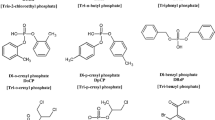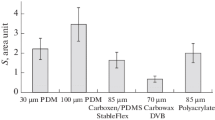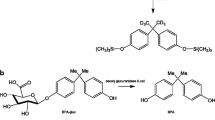Abstract
2,3-Dibromo-1-propanol (DBP) was used as an active flame retardant in the 1970s. It was also used as an intermediate in the preparation of insecticide formulations, pharmaceuticals and the flame retardants tris(2,3-dibromopropyl) phosphate (Tris-BP) and tetrabromobisphenol A bis (2,3-dibromopropyl ether). DBP is also produced in vivo as a metabolic product of Tris-BP in humans. In 1977, sleepwear containing DBP and Tri-BP was banned because of evidence of carcinogenicity animal studies. Although the production of DBP was reduced after 1977, studies show that DBP is still detected in indoor air and dust; hence, the U.S. population may be exposed potentially to DBP. Only a few methods have been reported in the literature for assessing exposure to DBP or Tris-BP by measuring DBP in urine. These methods are based on a labor-intensive and time-consuming liquid-liquid extraction for the isolation of DBP from the urine matrix. To measure urinary DBP in humans, a fast, accurate, and sensitive method was developed with a limit of detection of 0.1 ng/mL and extraction recovery of 96%. This method involves enzymatic cleavage of the DBP-glucuronide or sulfate conjugate, automated solid phase extraction, and analysis by gas chromatography-mass spectrometry using 1,4-dibromo-2-butanol as the internal standard.








Similar content being viewed by others
References
Barr DB, Wilder LC, Caudill SP, Gonzalez AJ, Needham LL, Pirkle JL (2005) Urinary creatinine concentrations in the U.S. population: Implications for urinary biologic monitoring measurements. Environ Health Perspect 113:192–200
Blum A, Ames BN (1977) Flame retardant additives as possible cancer hazards. Science 195:17–23
Blum A, Gold MD, Ames BN, Jones FR, Hett EA, Dougherty RC, Horning EC, Dzidic I, Carroll DI, Stillwell RN, Thenot J-P. (1978) Children absorb tris-BP flame retardant from sleepwear: Urine contains the mutagenic metabolite, 2,3-Dibromopropanol. Science 201:1020–1023
Eustis SL, Haseman JK, Mackenzie WF, Abdo KM (1995) Toxicity and carcinogenicity of 2,3-Dibromo-1-propanol in F344/N rats and B6C3F1 mice. Fund Appl Toxicol 26:41–50
Haseman JK, Hailey JR (1997) An update of the National Toxicology Program database on nasal carcinogens. Mutat Res 380:3–11
International Programme on Chemical Safety (1995) Environmental health criteria 173. Tris(2,3-dibromopropyl) phosphate and Bis(2,3-dibromopropyl) phosphate, Geneva, Switzerland
Lynn RK, Gould CG, Wong K, Kennish JM (1982) Metabolism, distribution, and excretion of the flame retardant, tris(2,3-dibromoproyl) phosphate (Tris-BP) in the rat: Identification of mutagenic and nephrotoxic metabolites. Toxicol Appl Pharm 63:105–119
National Institute of Environmental Health Sciences, Toxicological summary for tetrabromobisphenol A bis(2,3-dibromopropyl ether). Research Triangle Park, NC, 2002
National Toxicology Program (1993)Toxicology and Carcinogenesis Studies of 2,3-Dibromo-1-propanol in F344/N Rats and B6C3F1 Mice (Dermal Studies), Technical Report series TR-400, Research Triangle Park, NC: NTP, pp 202
National Toxicology Program (2005) 2,3-Dibromo-1-propanol. Report on Carcinogens, 11th Edition, Research Triangle Park, NC
Pival MJ, MsCoy EC, Gutter B, Rosenkranz HS (1977) Tris(2,3-dibromopropyl) phosphate: Mutagenicity of a widely used flame retardant. Science 195:76–78
Rudel RA, Camann DE, Spengler JD, Korn LR, Brody JG (2003) Phthalates, alkylphenls, pesticides, polybrominated dihenyl ethers, and other endocrine-disrupting compounds in indoor air and dust. Environ Sci Technol 37:4543–4553
St. John Jr. LE, Eldefrawi ME, Lisk DJ (1976) Studies of possible absorption of a flame retardant from treated fabrics worn by rats and humans. Bull Environ Contam Toxicol 15:192–197
Taylor JK (1987) Quality assurance of chemical measurements. CRC Press, Boca Raton, FL
U.S. Consumer Product Safety Commission (1977) CPSC Bans TRIS-Treated Children’s Garments, http://www.cpsc.gov/cpscpub/prerel/prhtml77/77030.html, May 2005
Westgard JO (2002) Basic QC Practices: Training in statistical quality control for health care laboratories. Westgard QC, Inc., Madison, WI
Acknowledgments
The authors thank Ruthann Rudel at the Silent Spring Institute for her suggestion that we develop this method. Additionally, we acknowledge Ralph D. Whitehead for the support given throughout this project., This work was supported in part by an appointment to the Research Participation Program at the Centers for Disease Control and Prevention, National Center for Environmental Health, Division of Laboratory Sciences, administered by the Oak Ridge Institute for Science and Education through an interagency agreement between the U.S. Department of Energy and CDC.
Author information
Authors and Affiliations
Corresponding author
Rights and permissions
About this article
Cite this article
De Alwis, G.H., Needham, L.L. & Barr, D.B. Automated Solid Phase Extraction and Quantitative Measurement of 2,3-Dibromo-1-Propanol in Urine Using Gas Chromatography-Mass Spectrometry. Arch Environ Contam Toxicol 53, 134–139 (2007). https://doi.org/10.1007/s00244-006-0094-3
Received:
Accepted:
Published:
Issue Date:
DOI: https://doi.org/10.1007/s00244-006-0094-3




